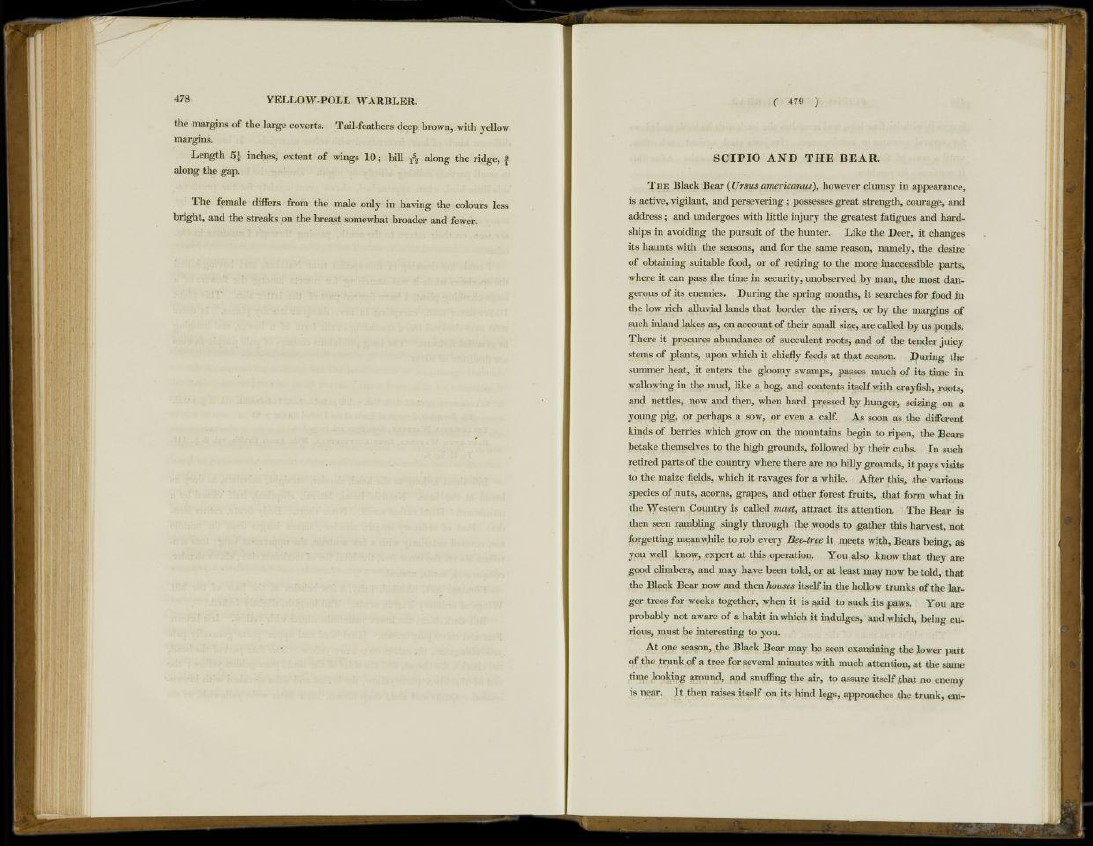
478 YELLOW-POLL WARBLER.
the margins of the large coverts. Tail-feathers deep brown, with yellow
margins.
Length 51 inches, extent of wings 10; bill T
5 2 along the ridge, f
along the gap.
The female differs from the male only in having the colours less
bright, and the streaks on the breast somewhat broader and fewer.
( 479 )
S C I P I O AND T H E BEAR.
THE Black Bear (Ursus americanus), however clumsy in appearance,
is active, vigilant, and persevering ; possesses great strength, courage, and
address; and undergoes with little injury the greatest fatigues and hardships
in avoiding the pursuit of the hunter. Like the Deer, it changes
its haunts with the seasons, and for the same reason, namely, the desire
of obtaining suitable food, or of retiring to the more inaccessible parts,
where it can pass the time in security, unobserved by man, the most dangerous
of its enemies. During the spring months, it searches for food in
the low rich alluvial lands that border the rivers, or by the margins of
such inland lakes as, on account of their small size, are called by us ponds.
There it procures abundance of succulent roots, and of the tender juicy
stems of plants, upon which it chiefly feeds at that season. During the
summer heat, it enters the gloomy swamps, passes much of its time in
wallowing in the mud, like a hog, and contents itself with crayfish, roots,
and nettles, now and then, when hard pressed by hunger, seizing on a
young pig, or perhaps a sow, or even a calf. As soon as the different
kinds of berries which grow on the mountains begin to ripen, the Bears
betake themselves to the high grounds, followed by their cubs. In such
retired parts of the country where there are no hilly grounds, it pays visits
to the maize fields, which it ravages for a while. After this, the various
species of nuts, acorns, grapes, and other forest fruits, that form what in
the Western Country is called mast, attract its attention. The Bear is
then seen rambling singly through the woods to gather this harvest, not
forgetting meanwhile to rob every Bee-tree it meets with, Bears being, as
you well know, expert at this operation. You also know that they are
good climbers, and may have been told, or at least may now be told, that
the Black Bear now and then houses itself in the hollow trunks of the larger
trees for weeks together, when it is said to suck its paws. You are
probably not aware of a habit in which it indulges, and which, being curious,
must be interesting to you.
At one season, the Black Bear may be seen examining the lower part
of the trunk of a tree for several minutes with much attention, at the same
time looking around, and snuffing the air, to assure itself that no enemy
is near. It then raises itself on its hind legs, approaches the trunk, em